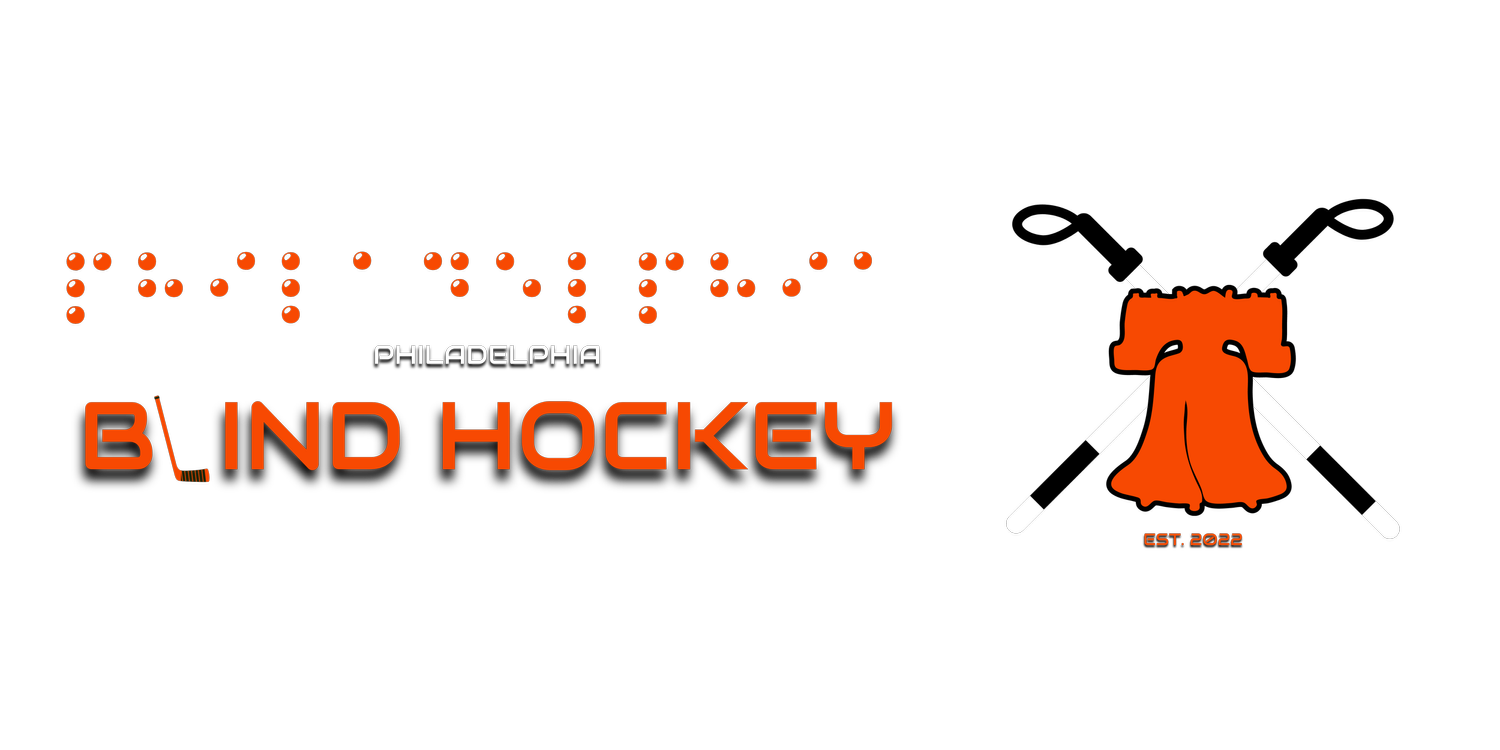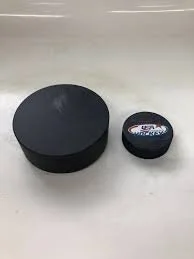What is Blind Hockey
Blind Hockey has been played in Canada since the early 1970’s. The sport was first played in the U.S. on October 18, 2014 with the first ever Blind Hockey Summit in Newburgh, NY. At the 2015 USA Hockey Disabled Hockey Festival, in Buffalo, NY, blind Hockey was introduced to the rest of the Disabled Hockey Community.
THE GAME
Blind Hockey is the same fast-paced sport as Ice Hockey with just one main difference – all of the players are legally blind. Players must be classified as eligible in one of the three International Blind Sports Federation (IBSA) classifications.
Visual Classifications
B1: No light perception in either eye up to light perception, and an inability to recognize the shape of a hand at any distance or in any direction.
B2: From ability to recognize the shape of a hand up to visual acuity of 20/600 and/or a visual field of less than 5 degrees in the best eye with the best practical eye correction.
B3: From visual acuity above 20/600 and up to visual acuity of 20/200 and/or a visual field of less than 20 degrees and more than 5 degrees in the best eye with the best practical eye correction.
USABA Recognized Low Vision Classification
B4: From visual acuity above 20/200 and up to visual acuity of 20/70 and a visual field larger than 20 degrees in the best eye with the best practical eye correction.
The main modification of this sport is the adapted puck that makes noise and is both bigger in size and heavier in weight than a traditional hockey puck. This will allow the puck to slow down while sliding on the ice for those players with less vision or no vision an opportunity to track the puck. Players’ levels of vision range from legally blind – 20/200 or less in your better eye or your field of vision is less than 20 degrees– to totally blind.
Blind Hockey is a great spectator sport as it is easily recognizable to the average hockey fan. There are minimal rule adaptations to help with gameplay and player safety. The differences a hockey fan might notice:
Custom 3 foot high nets are used rather than the traditional 4 foot nets to keep the puck low and near the ice so it can make noise and be tracked aurally.
Teams must complete one pass prior to being able to score in the attacking half of the rink – this provides both the low vision defense and the goalie an extra opportunity to track the puck.
The game is played with standard IIHF safety protocols including no-touch icing, and crease violations to ensure utmost player safety.
All players must wear full protective gear including face mask.
Positioning – Players with most vision (B3-B4) usually play forward positions while players with less vision (B2-B1) tend to play defense. All goalies have no vision (B1) or have vision occluded
The Puck
In the game of Blind Ice Hockey, there is an adapted puck that makes noise and is both bigger and heavier than a traditional hockey puck. The large size and slower speed help visually impaired players see the puck, while the noise allows low vision or no vision players to track it.
Blind Hockey Pucks are made of hollow steel and contain 8 ball-bearings. The pucks are made by hand by welding together a steel band around 2 circular discs, filled with ball bearings, then painted black. A Blind Ice Hockey puck generally lasts for only about two highly competitive games as it becomes dented when hitting the posts, skates, sticks and the boards.
Material: 22 gauge steel
Diameter: 5 ½ inches / 14 centimeters
Height: 1 7/8 inches / 4.8 cm
Weight: 7.8 oz/ 220g
Color: Black
Contents: 8 ball bearings
The Teams
The sport of Blind Hockey is governed in the United States by USA Hockey. Currently there are two major annual competitions for the sport of Blind Hockey in the United States: the USA Hockey which are Blind Hockey Summit which takes place in the fall, and the USA Hockey Disabled Festival, Blind Hockey Division which takes place in the spring. There are currently 19 Blind Hockey programs established in the United States as well as more additional teams starting up in the upcoming year. All programs include learn to skate players through advanced level in both hockey skills and playing the game. Blind hockey programs in the US includes:
Anaheim Blind Hockey
Boston Blind Hockey
Carolina Hurricanes Blind Hockey
Chicago Blackhawks Blind Hockey
Colorado Visionaries Blind Hockey
Dallas Blind Hockey
Hartford Braillers
Indiana Checkers Blind Hockey
Maine Blind Bears
Michigan Blind Hockey
Minnesota Blind Hockey
New York Metro Blind Hockey
New York Nightshade
Pittsburgh Blind Hockey
Seattle Blind Hockey
St. Louis Blues Blind Hockey
Washington Blind Hockey Club
International Blind Ice Hockey Federation (IBIHF)
The International Blind Ice Hockey Federation (IBIHF) was created in 2015 to lead the development of the sport of Blind Ice Hockey, focus on international development and recruitment, and gain inclusion in the Winter Paralympic Games. The IBIHF has currently has two member countries where the sport of Blind Ice Hockey is played – Canada and the USA – and is focused on recruiting six more countries to develop programs in order to have the necessary eight countries for a World Championships, and the opportunity to apply for the Paralympic Games.
The IBIHF objectives are:
To oversee and govern the adapted rules of Ice Hockey for the Blind
To develop a classification code to allow all blind and visually impaired hockey players to fairly compete in the sport of Blind Ice Hockey
To grow the number of players and competition opportunities in our member nations
To recruit a minimum of 6 other member nations
To host a World Championships for the sport of Blind Ice Hockey with 8 national teams
To apply for inclusion in the Winter Paralympic Games


